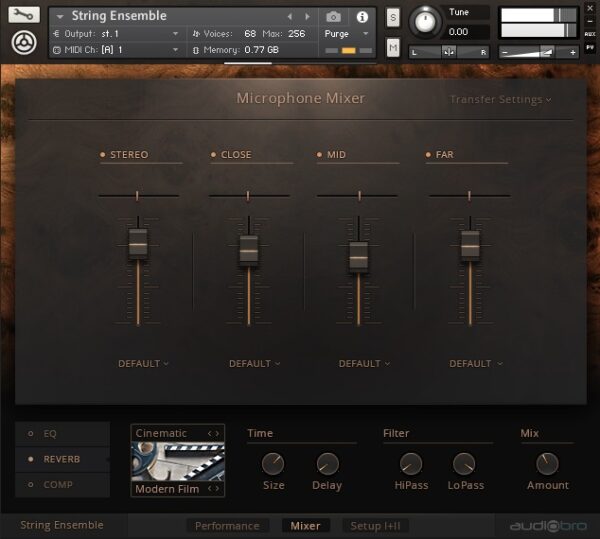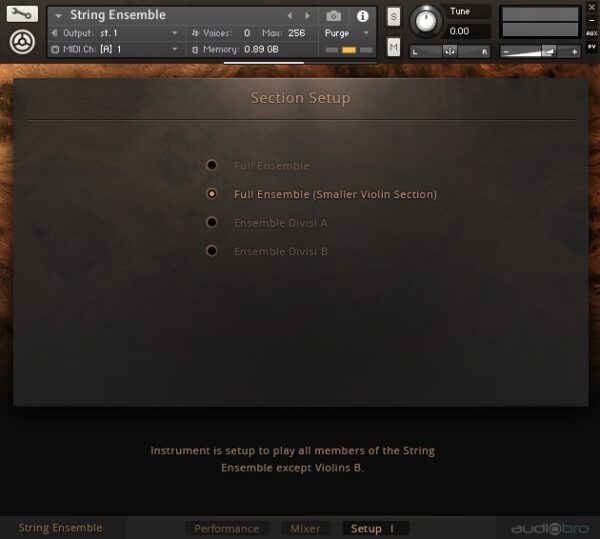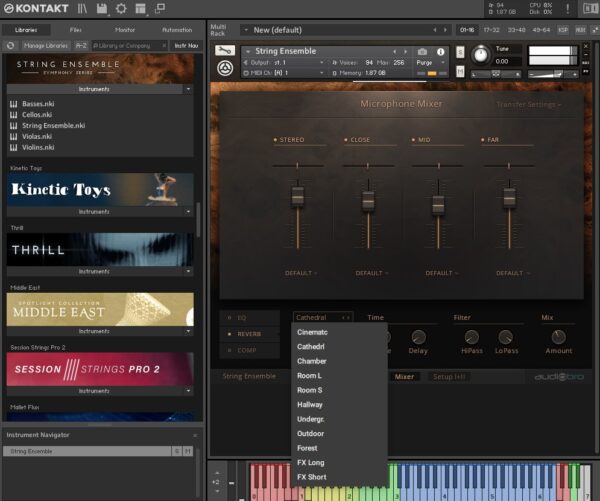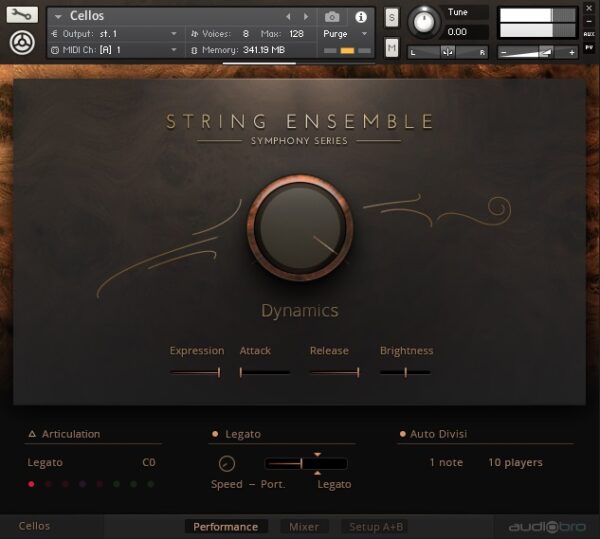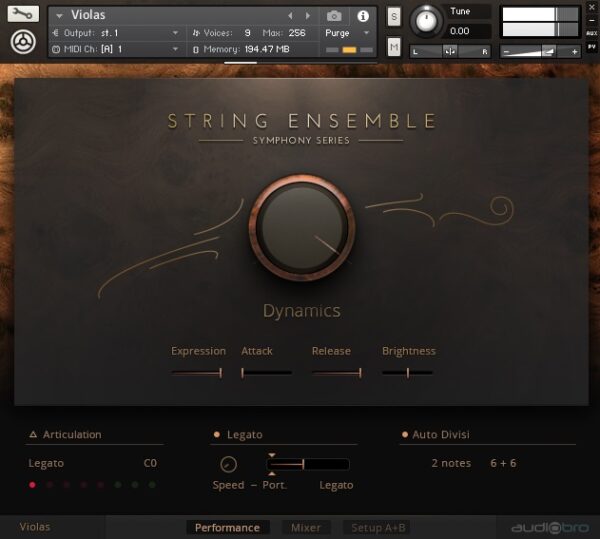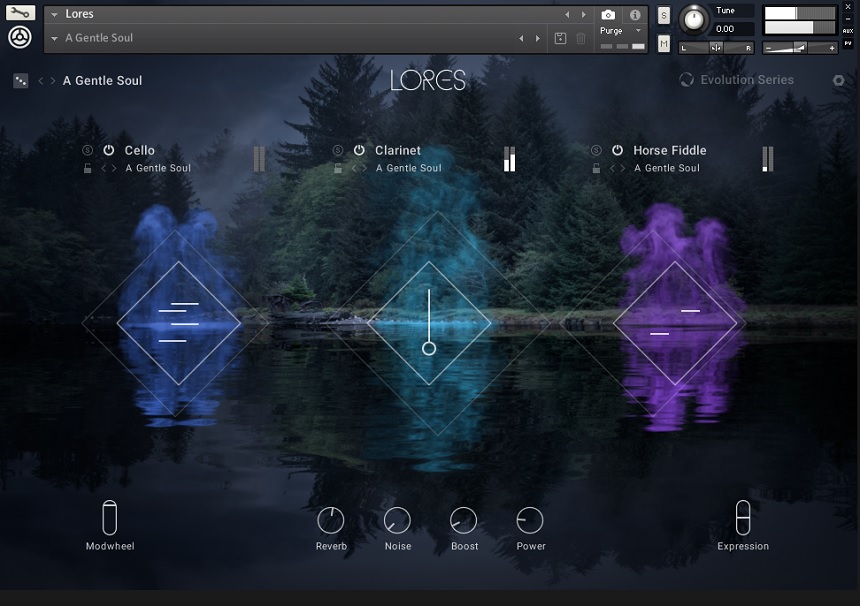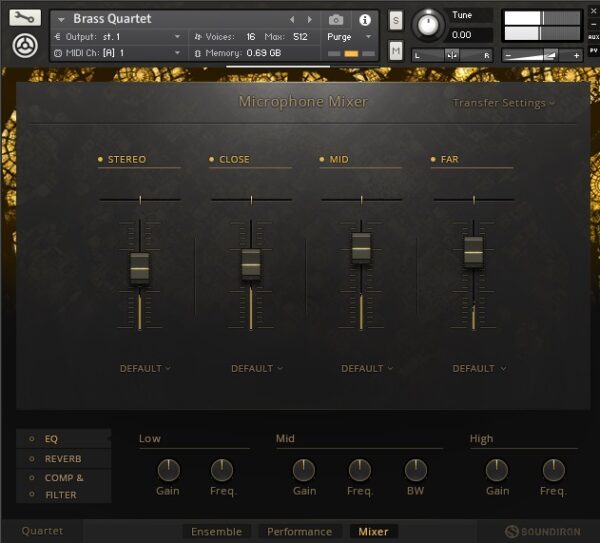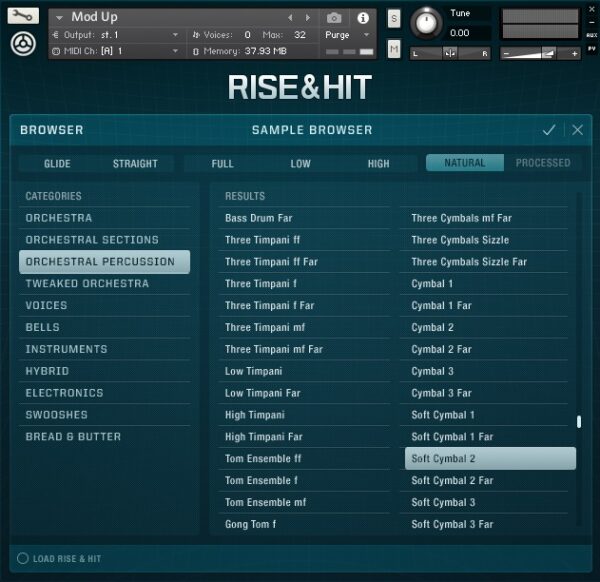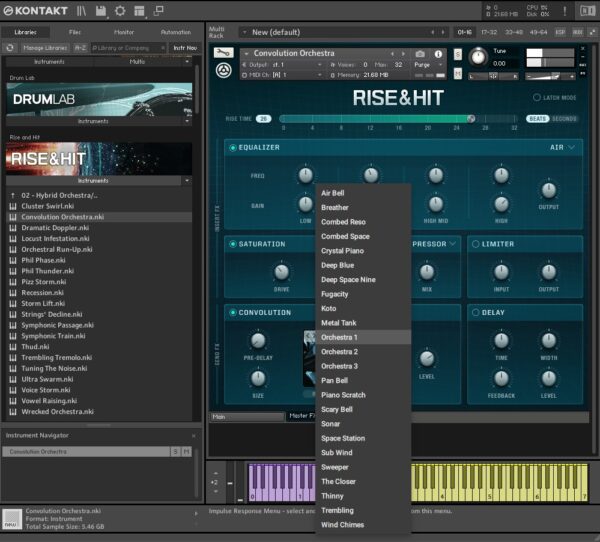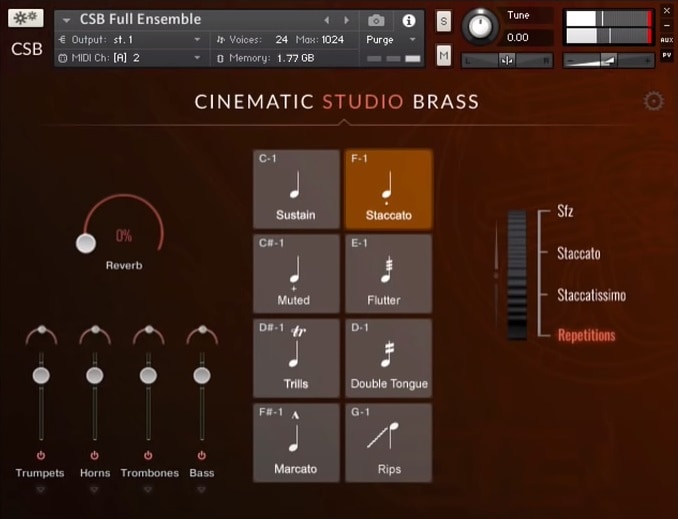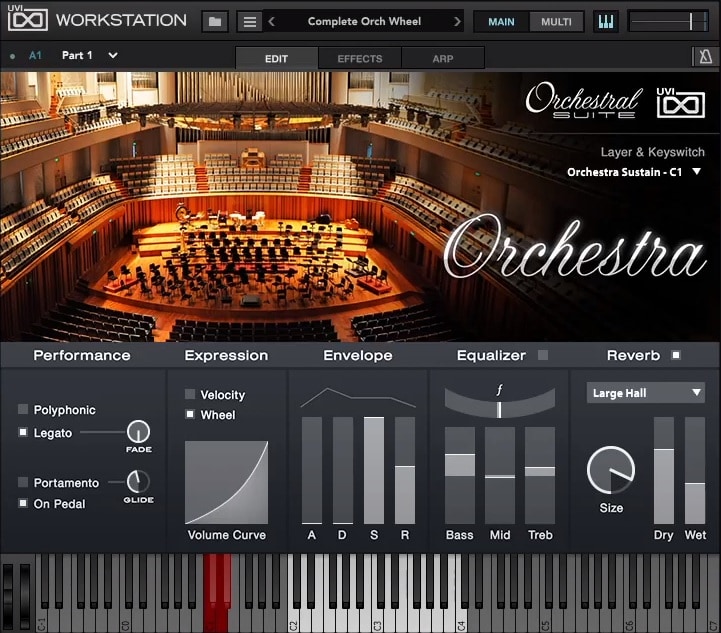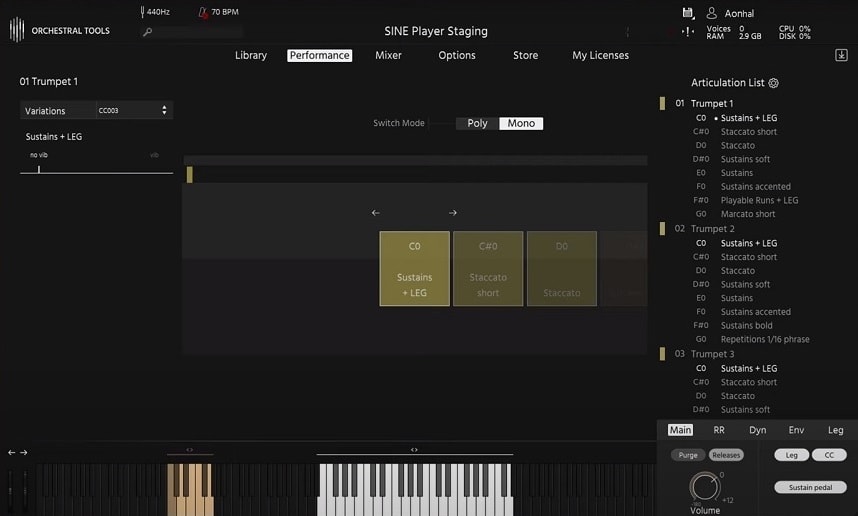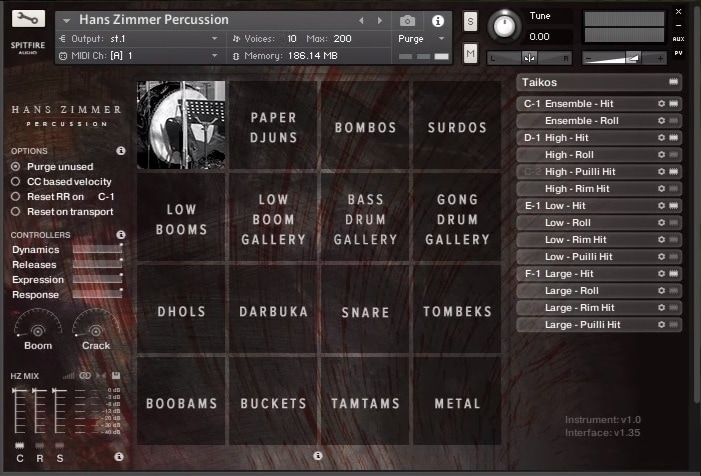String quartets and orchestral ensembles are great sonic tools to make your track stand out. They add character, dimension, and depth to any song, no matter which style. For example, some great pop songs, like The Beatles’ “Yesterday” or Coldplay’s “Viva La Vida.”
They wouldn’t have the same power if there weren’t an orchestra backing them up, creating the perfect atmosphere for it.
With that said, we’ll take a look at the most popular orchestral plugins and libraries available in 2024.
In a nutshell, here they are:
1. Abbey Road One Orchestral Foundations
2. Heavyocity Symphonic Destruction
3. NI Symphony Series String Ensemble
6. NI Symphony Series Brass Ensemble
8. Orchestral Tools Berlin Woodwinds
9. IK Multimedia Miroslav Philharmonik 2
10. NI Symphony Series Woodwind
11. Strezov Sampling Jade Ethnic Orchestra
It’s a bit hard to have an entire ensemble available at your home studio, but gladly plugins and sample libraries are a common thing in the 21st century. In the past, recording that many musicians would require a large studio, excellent microphones, and many musicians ready for you.
This work is now limited to the software companies, which guarantee to capture each instrument’s essence as closely as possible so you can use it however you’d want.
This list gathers some great options regarding orchestral VST plugins and Kontakt libraries available in 2024. Most are paid, but some freeware options can get you started in orchestral arrangement.
Top 12 Orchestral VST Plugins & Kontakt Libraries 2024
1. Spitfire Audio – Abbey Road One Orchestral Foundations (Plugin)
More Info & Price
This plugin features samples recorded in a coveted studio room and brings cinematic quality to your orchestral sounds.
Abbey Road’s Studio One has seen a lot throughout its history. This room is famous for its sonic capabilities and adequate space to fit an entire ensemble, from iconic bands to ambitious recordings.
Thinking of such big standards, Spitfire Audio carefully recorded a 90-piece symphonic orchestra with great microphones, acoustics, engineers, and the best players available. As a result, every instrument gets the deserved attention, so it’ll sound as it should, with precision regarding sonic details and dynamics.
Key Features:
- Five distinct libraries:
Each of five distinct Abbey Road One libraries is designed to evoke a particular aspect in your project. “Vibrant Reeds” adds brilliance and color to your track by pairing oboes and clarinets with oboes and Cor Anglais at the same time; “Grand Brass” merges horns and tube with horns and cellos for maximum deepness; “Wondrous Flutes” brings more brilliance with flute and piccolo performances; “Legendary Low Strings” combines the cello and bass sections for a beautiful low-end; and, finally, “Sparkling Woodwinds” adds the deserved higher harmonics to everything.
- Articulations and dynamic layers:
This collection features 69 different articulations paired with five distinct dynamic layers. You can also find your perfect sound by selecting up to 10 individual mics (with great options like a pair of RM1B and some ribbons mics) with two mix signals.
Varying these parameters allows you to enhance the overall sound quality and craft a unique approach to your score.
- Iconic spot:
Abbey Road is perhaps the most famous recording studio globally, but there’s a reason for that: the unique recording rooms, with their exquisite acoustics, make everything played there sound fantastic.
Studio One featured many recording sessions for famous movie soundtracks, such as several “Harry Potter” scores, “Star Wars: Episode VI – Return of the Jedi,” “1917,” and “Avengers: Endgame,” just to name a few.
- A cinematic experience:
The sections are organized into ensembles, featuring different instrument combinations that can inspire you quickly and easily. The strings are divided into “Low” and “High,” brass section into “Low,” and horns, trumpets, and woodwind into “Low” and “High.”
Dividing these instruments into lower or higher sections can instantly help you find great sound as if they were just recorded in your room.
Compatibility:
The library is available for macOS 10.10 to 11 (64-bit only) and Windows 7, 8, or 10 (64-bit only and the latest Service Pack required). It comes in VST2, VST3, AAX, AU, and NKS plugin formats.
Summary:
The dynamic variety, allied with the acoustics offered by Abbey Road’s Studio One, makes this one a great option. Although it’s more focused on cinematic productions, you can use this collection to add any orchestral bits necessary to make your track sound as good as if you’ve just recorded with an actual orchestra.
Related Reading:
Top 11 Spitfire Audio Libraries & Plugins
2. Heavyocity Symphonic Destruction (Kontakt Library)
More Info & Price
A deconstructed orchestra library, ready to push your inspiration up to its limits.
Heavyocity’s Symphonic Destruction delivers innovative results to hybrid orchestral scoring by blending traditional combinations, ingrained sound design, and profound braams in one single library. As a result, all sounds will be fresh and revamped, as this collection aims to deconstruct the orchestra ensemble as we know it.
A massive collection of cinematic elements – from full orchestral portatos to detuned staccatos – allow you to create infinite soundscapes, all worthy of much energy and vigor while maintaining the characteristic huge sound aspect that only an orchestra can provide. So be ready to unleash your most audacious and wild ideas instantly.
Key Features:
- Three different instrument types:
Symphonic Destruction provides you with three different instrument types: “Performers,” which consists of instruments that can have key switches to alternate between different sounds, “SD Designer,” tailored for deep sound designing, and “SD Loop and Braam Designers,” a variation of the previous type but designed to playback and layer any loops or braam noises.
- Spaced out:
A distinctive “Space” section contains two cherished effects on one single page. Here you’ll find a delay and reverb that can help you instill the proper ambiance and sense of acoustic. The delay features five different controls (“On/Off,” “Time,” “Feedback,” “Width,” and “Amount”) that can be tweaked at your will, while the reverb features only three commands (“Delay,” “Size,” and “Mix”), in addition to all impulse responses being fairly fixed in their character.
- Three microphone positions:
Every sample was recorded with three different microphone positions, so you can expect to alter these in any way you want to. Including “Main,” “Hall,” and “Rev FX” positions, the mixer allows you to set each value accordingly through specific faders. You also have “Mute,” “Solo,” and “Pan” options in each position.
- Modulators:
There are two modulators: “Gate” and “Dynamics.” Each can create a different approach to your instruments, either by modulating the output volume (“Gate”) or by controlling the dynamics level of the instrument (“Dynamics”) over time to create rhythmic effects. You can set the “Rate,” “Steps,” and “Range” in each section to instantly achieve new sounds and textures.
Compatibility:
The library is available for macOS 10.14, 10.15, 11, or 12 (latest update) and Windows 10 (64-bit only). It comes in VST, VST3, AAX, and AU plugin formats.
Summary:
This is a feast for sound designers. With Symphonic Destruction, it’s easier than ever to develop authentic cinematic sounds worthy of great productions with as few mouse clicks as possible.
All tools, configurations, and parameters inspire modern and new soundscapes, ranging from calm and serene timbres to more explosive, overwhelming braams. In between, you can have multiple different new ideas that can fit right into your next production or at least inspire you to create something out of the box.
Related Reading:
7 Best Heavyocity Kontakt Libraries For Music Production
3. NI Symphony Series String Ensemble (Kontakt Library)
A partnership between NI and Audiobro results in the creation of this enormous 60-player string orchestra.
Like any other string section of a symphonic orchestra, four sections form the basis of this ensemble – basses, cellos, violas, and violins. In addition, a fifth Ensemble preset is included for a whole string section mapped across the MIDI controller.
The GUI is simple and intuitive, creating an easy user experience. It is divided into three sections or tabs – Performance, where the dynamics, envelopes and articulations can be adjusted; Mixer, for balancing the sound and sound-shaping with effects; and, Setup, where you can decide the size of the orchestra.
Key Features:
- Legato:
A subject for discussion about string libraries is the legato since it’s the most important feature. But be at ease; the legato in SSSE is very well-implemented. The transitions to portamento are controlled by velocity and trigger when kicking below the threshold; this threshold can be adjusted with the slider.
The mod wheel controls the crossfade of dynamics between layers. The amount of vibrato progressively increases with each layer for realism and expression, providing a vibrato control knob in the Legato Vib. Ctrl section to adjust the said amount.
- Section Setup:
The size of the orchestra can be determined with the controls on the Setup tab, allowing users to split the instruments into smaller sections for a more intimate sound. It’s also possible to achieve more control and detail over the articulations and dynamics for each section using the options available to control Divisi A and B individually.
Each Divisi part is a unique recording, meaning that different samples are triggered when one or the other. The section consists of 16 violins I (8 for part A and 8 for B), 14 violins II (7 for A and 7 for B), 12 violas (6 for A and 6 for B), 10 cellos (5 for A and 5 for B), and 8 basses (4 for A and 4 for B).
- Divisi:
Besides being able to decide the number of players in the string sections, the other reason they were recorded in A and B parts is to implement the Divisi function, which uses the same scripting as the LA Scoring Strings. The violins allow up to four Divisi splits since they’re 30 players separated into two sections (I and II) and go as follows: 2 notes = 16/14, 3 notes = 16/7/7, and four notes = 8/8/7/7.
The rest of the instruments split into two parts, with the violas splitting in 6/6, the cellos in 5/5, and the basses in 4/4. Adding more than four voices for the violins and more than two for the rest of the instruments increases the number of players.
- Mixer and FX:
There are 4 microphone channels for each patch – stereo, close, mid, and far – to adjust the ensemble’s placement perception; this section also comes with panning sliders beside the faders.
For sound-shaping, there’s a parametric EQ with three bands, a compressor, and a convolution reverb with 104 impulse responses, most of them made by Audiobro, including 4 cinematic ambiences.
There’s also the handy option for copying the settings to another ensemble as long as they’re all in the same Kontakt instance.
Compatibility:
The library is available for Kontakt Player 5 or higher. Kontakt is available for Windows 10 or higher and macOS 10.14 or higher, both 64-bit only. It comes in VST 2/3, AU, and AAX formats.
Summary:
One issue I find in this library is the lack of a solo library along the ensemble, unlike Brass collection, its predecessor in the NI’s Symphony Series. Despite that, String Ensemble offers a great sound and its Divisi feature and manageable vibrato give it an authentic quality, unlike many other string plugins.
It is a big investment but also a big reward; even more so once you understand how to tweak its functions to get the sound you want.
Related Reading:
Top 7 Strings Kontakt Libraries (And 3 Free Libraries)
4. Native Instruments Lores (Kontakt Library)
A special scoring tool for adding mystery, ambiance, and beauty to your tunes, Lores blends rich layers of traditional and ancient sounds.
Native Instruments releases LORES in collaboration with the Evolution Series. The new tool provides quality sounds, vibrations, and melodies in different genres.
A set of expressive and realistic instruments has been made by Native Instruments. The new Kontakt library provides a wide range of sound creation options in conjunction with the Evolution Series and is guaranteed to be a useful addition to any producer’s toolset. LORES is available now from the Native Instruments website.
Key Features:
- Samples:
LORES also includes 72.3 GB of audio files, and 373 factory presets. You may get into the engine and build brand-new soundscapes from scratch, or you can utilize the supplied presets for fast enjoyment. For example, you may amplify sounds with dynamic effects or stage them inside three-dimensional smoke plumes.
- Instruments:
Over 300 hand-played joints and 16 instruments make up the core. Woodwinds, traditional strings, rare chordophones, and unusual instruments like the guitar, shakuhachi, Mongolian violin, or medieval pipes are some sound sources used in the compositions. But then, all of this is included in a well-designed user interface that enables you to combine up to three separate sources.
- Humanizer:
The human experience of telling stories via song is universal, and LORES carries on this long tradition with unique embellishments. On the performance level, unpredictable swells, unanticipated tremolos, and stray harmonics produce genuine movement in the music played by the musicians who sampled.
In addition, instruments may be physically staged in three-dimensional smoke plumes using multi-mic recording, giving dynamic realism to your shows.
Compatibility:
The full version of Kontakt 5.8.1 or higher is needed. It runs on macOS 10.9 or higher (64-bit only) and Windows 7 or higher (64-bit only).
Summary:
This collection is ideal for those who wish to give their music a little more reality and motion. More than 300 hand-played articulations are used to voice the 16 instruments, allowing you a lot of flexibility in how you may design your soundscape. The outcome is a distinctive and adaptable collection since they meticulously captured the instruments to maintain their original character.
5. VSL Synchron Pianos Bundle (Plugin)
More Info & Price
This collection gathers the best and most beautiful pianos, hand-picked and recorded in Vienna.
Vienna Symphonic Library offers a variety of orchestral-oriented sample libraries with solid quality and diversity. Synchron Pianos Bundle is focused on iconic and great-sounding grand pianos. It is based on the Synchron Player Engine, designed to deal with multiple microphones being recorded simultaneously and efficiently.
The bundle comprises six different pianos: Bösendorfer Imperial, Steinway & Sons D-274, Yamaha CFX, Blüthner 1895, Bösendorfer 280VC, and Bösendorfer Upright. Each features a specific sound profile and bears some special characteristics, but they all sound great in their own way.
Key Features:
- Handy presets:
VSL included some factory presets that might be useful in nailing the perfect tone. There are three different versions of the presets: “Room-Mix Presets,” “Decca Three Multi-Mic Presets,” and “Surround To Stereo Downmix Presets.” The first one features as few microphones as possible but with a well-balanced mixing that ensures a great sound from the moment you load it.
The second one deals with the room signals, producing a more slender and less-oriented sound with loads of room adjustments. The third and final version uses all available microphones for enhanced flexibility on the mix, especially useful when dealing with details, a better mic positioning, or dynamic nuances.
- Play and Mix view:
This plugin can offer two primary visualization interfaces, a “Play” and “Mix” dedicated views. The “Play” features controls that influence your final sound, such as “Volume,” “Reverb,” “Dynamic Range Control,” “Soft,” or “Sustain Pedal,” and “Body.”
You can also tweak the MIDI sensitivity or shift the piano sound four octaves up or down. The “Mix” view brings dedicated faders to each microphone, with the possibility to add effects such as delay and reverb and equalize everything to your taste. You can also mute or pan each mic the way you want to.
- Microphone positions:
Multiple plugins offer this configuration, but VSL brought many options to tweak from. You can choose between three different “Close” and two “Mid” microphones, including Royer ribbons, Neumann, and Sennheiser options.
The ambiance, however, brings more features than usually seen: there are two “Main/Room” mics, one “Main Surround,” one “High Stereo 3D,” and one “High Surround 3D,” ensuring full details when capturing the sound’s resonance.
- Channel FX
Aside from the usual reverb and delay options, you’ll get more effects options than usual with a “Saturator,” which emulates tape distortion or tape overload, a “Cabinet,” which simulates famous cabinets, like the AC30 or the Marshall 1960B, a “Compressor,” an “Expander” and “Limiter,” and even a “Noise Gate”!
Compatibility:
This plugin is available for macOS 10.13 or higher (64-bit only) and Windows 8.1 and 10 (64-bit only). It comes in VST, AAX, and AU plugin formats.
Summary:
There aren’t many different or innovative functions, but you can count on great tools to further extend your sound’s quality, like the channel FX and multiple microphone positions. But, of course, everything sounds really good from the start, so you have to tweak the timbers that suit your needs best.
Related Reading:
Top 8 Piano VST Plugins For Musicians
Top 12 FREE Piano Plugins That Sounds Like Paid
6. NI Symphony Series Brass Ensemble (Kontakt Library)
More Info & Price (Trial Available)
A 32-piece symphonic brass section was developed in partnership with Soundiron.
Recorded in St. Paul’s Church in San Francisco by Soundiron, this collection is comprised of two libraries: Solo and Ensemble, each one including the four instruments of a symphonic brass section (trumpet, French horn, trombone, and tuba) and a group section or Ensemble (Quartet for Solo).
The ranges of the instruments in the Ensemble and Quartet patches can be adjusted and also overlapped when unlinked. Also, instruments can be deactivated – which helps save CPU usage – in case you need just trumpets and horns or trumpets and trombones, for example.
Key Features:
- Articulations:
Over 100 articulations were recorded and provided to the instrument sections.
They’re distributed across all the sections and solo instruments of which each come in six types of preset: Effects, Expression, Legato, Staccato, Sustain, and a general-purpose one with the name of the according instrument – meaning that, for example, the trumpet section would be reflected in Trumpet Effects, Trumpet Expression, Trumpet Legato, Trumpet Staccato, Trumpet Sustain, and Trumpet; and so on with the rest of the instruments.
This can be inconvenient since each preset comes with just a set of articulations according to its description, but none of them have all the articulations; the general-purpose one has a lite mixed set of all the articulations (but not all of them as previously mentioned).
The reason for this is reducing the load on the CPU, which is also why it is possible to purge articulations in the articulations tab which reduces the load. This also simplifies the process of performance or MIDI drawing (depending on your style) to only use what you need.
Although, it could have been possible to have this option and also an almighty all-articulations preset instead of having to load several presets to be able to make use of several sets of articulations.
- Repetition Tool:
You can repeat short note strikes two or three times or keep it repeating indefinitely with this feature while pressing down on a key without releasing when activated. Also, this feature allows to create patterns of 1/8th notes or 1/16th notes with accents. This is very useful for playing rhythmic sections or ostinatos.
- Dynamics:
The upper segment of the main page in the GUI features the dynamics knob, which controls a combination of volume and intensity and can be mapped to the mod wheel. There are also slider controls for attack, release, tightness and motion to fill the performance with realism and expression.
- Mixer & FX:
This section features a four channel mixer with stereo, close, mid, and far microphones – stereo being a combination of the three aforementioned as a RAM-friendly option – with toggle on/off controls and panning sliders.
Below, we have a parametric EQ with three bands, a compressor, a low pass filter, and a convolution reverb with 100 different impulses helping add some ambience, which works great for presets with shorter release times. There’s also a Transfer Settings feature that allows users to copy the settings in the mixer section to other instruments.
For some reason, this feature does not work when trying to copy the settings of a section to a solo instrument, nor the opposite.
Compatibility:
The library is available for Kontakt Player 5 or higher. Kontakt is available for Windows 10 or higher and macOS 10.14 or higher, both 64-bit only. It comes in VST 2/3, AU, and AAX formats.
Summary:
This collection is an nice choice as it offers a lush sound, great sound-shaping tools, a fair number of articulations and impulse responses, and both Solo and Ensemble options. Its weaknesses can be easily overcome, although it requires patience and spending some time tweaking the presets and effects to get the sound you need.
Related Reading:
Top 12 Brass Plugins & KONTAKT Libraries (+ Best FREE Plugins)
7. NI Cinematic: Rise & Hit (Kontakt Library)
Rise and Hit is a massive collection of cinematic and orchestral sounds created by Native Instruments.
This Kontakt instrument is perfect for adding tension to your tracks. It has over 650 Risers and over 1000 Hits, all created from a wide range of sources within the over 8GB library.
Key Features:
- Built-in Effects:
Within Rising and Hit, many built-in effects help you shape your sounds. There are fine-tuning controls, compression, saturation, multiple EQs, 26 different filters, dynamic controls, distortion controls, and classic reverbs and delays. All these effects can be used on each layer for even more control over the sounds you create.
- Multiple sample lengths:
Each built-in sound within Rising & Hit has multiple sample lengths. This means that once you’ve found a sound you like, you can use it in multiple ways. So whether you want a quick Woosh-type riser or a slowly built-up riser, then Rise & Hit has you covered, and the quality of the sounds will not be affected, no matter how long or short.
- The Interface/Design:
Rise & Hit is a very visually pleasing plugin. All the controls are labeled appropriately, so you don’t need to guess what the control does. The visual feedback when shaping your sounds is also useful when you start, as it gives you a better understanding of how the controls affect the audio.
The overall design of the plugin is nice and simplistic, Native instruments have chosen not to go for the black background with color accents style designs that are becoming more and more frequent, and it’s nice to see an original color scheme for a plugin of this caliber.
Compatibility:
This plugin requires Kontakt 5.8.1 or higher and is compatible with both the Full and Free versions of Kontakt. This plugin is available for macOS 10.11 or Higher and Windows 7 or Higher.
Summary:
Good plugin for all your Risers and Hit needs, especially if you need it for cinematic purposes. The sheer number of sounds means you won’t run out of new sounds and ideas. In addition, all the built-in effects mean you don’t need to load up additional plugins saving you time and processing power.
8. Orchestral Tools Berlin Woodwinds (Plugin)
More Info & Price
This woodwind bundle will get the colors and shades into your next symphonic track.
Orchestral Tools’ second plugin in our list reinforces what the company wanted from the beginning: to re-invent orchestral sampling. They’ve achieved so by offering first-class orchestral sounds with enough detail, consistency, and dedication to make it stand out among other options in the market.
Berlin Woodwinds consists of instruments like flute and clarinet, which can contribute to a colorful and rich sound spectrum in an orchestral production. All instruments were recorded with extreme care and attention to detail, making your track stand out and be as realistic as possible.
Key Features:
- Woodwind runs:
The woodwind section is one of the most suitable for scale runs. Flutes, oboes, clarinets, and piccolos usually go very well, with fast lines played up and down the octaves, shimmering over the orchestra with much brilliance and presence.
Berlin Woodwind comes with the “Runs Builder” tool that ensures every recorded run will sound as smooth and realistic as possible in any tempo you’d like to set your track. It includes the most commonly used scales, such as major, minor, whole tone, chromatic, and many others.
- All figurations present:
It’s definitely not easy to recreate all woodwind gestures and figurations and translate them into MIDI, as many articulations are required to sound simultaneously in order to deliver a decent, realistic performance.
Since most woodwind gestures are about rhythm, Orchestral Tools developed a way to stack articulations on top of one another, so multiple techniques can be used when executing a passage. The prerecorded “Triple Tongue Patch” is one of the elements responsible for such realism, as it can adapt to any tempo and sound just as well.
- Recorded with excellence:
All material contained in the Berlin Series was recorded in one of the best acoustic spaces for orchestral productions, the Teldex Scoring Stage. This iconic space features quality acoustics, ideal for large ensembles such as orchestras and renowned with multiple award-winning recordings.
From the London Symphonic Orchestra to famous composers like Danny Elfman, the number of iconic performances held there is vast. You can have that same quality in your next production.
- Balanced techniques:
All instruments, dynamic ranges, articulations, and microphone positions are balanced to keep a natural orchestral ambiance in the Berlin Series. The articulations present a soothing combination between one another, inciting realism and fluid playability, and each dynamic range of the contained instruments is modeled after reference recordings done with an authentic ensemble.
The release samples were painstakingly edited to preserve natural room acoustics, and the microphone positions are balanced well enough to finish setting the perfect ambient sound for your track.
Compatibility:
This plugin is available for macOS 10.13 or higher (64-bit only) and Windows 10 (64-bit only). It comes in VST, AAX, and AU plugin formats and works with the SINE Player.
Summary:
The Berlin Series excels at delivering great products, each focused on an orchestra’s specific aspect or a section. Berlin Woodwinds brings the flutes, piccolos, clarinets, and oboes straight to your track with multiple configurations – from mic positioning to varied articulations – that will sound as if you have a whole woodwind section in your room.
The attention to detail when it comes to runs and each sample’s sound quality is extreme, and without a doubt, this will be reflected in your next cinematic production.
Related Reading:
Top 12 Woodwind Plugins (And KONTAKT Libraries)
9. IK Multimedia Miroslav Philharmonik 2 (Plugin)
More Info & Price
A fully-featured symphonic workstation with its own built-in DAW included in the package.
Miroslav Philarmonik 2 is a ground-breaking vision from a master artist incorporated into a brand new virtual instrument that can help you with any orchestral arrangements. All instruments were performed with the best musicians possible to ensure the overall quality.
Everything is gathered in a single display that should take care of your regular needs, such as leveling each instrument and adding whichever effects you’d like. The interface, by the way, resembles a friendly digital audio workstation that gives you access to every section or single instrument among the various included.
Key Features:
- Synth engine:
Can you imagine running an entire orchestra through a synthesizer? Well, that’s entirely possible now. Accessing the “Edit” mode will unveil a section with multiple controllers to adjust your tone better, but the unusual thing is to have a synth with three different sampling engines and ten filters that can be used to shape and transform your sound. You can set the perfect and most audacious sounds right away and expand your creative needs once and for all.
- Multiple FXs:
There’s a considerable number of effects present in Miroslav Philarmonik 2. All of the 34 options are from the acclaimed SampleTank 3 plugin, including five equalizers, four dynamic processors, seven filters, nine modulation effects, and nine reverb and delay effects. They’re all very versatile and easy to use, allowing for professional productions to be created instantly.
- SampleTank integration:
Without any additional installations or conversions, MP2 can work with SampleTank 3 for coherent integration into your existing music production workflow. You can manage and edit every sample the way you want to in a simple and effective user interface. The T-RackS features are also included, especially in all processing effects present.
- Macros editing:
Deriving from the SampleTank 3 integration, the macros editing provides eight of the most critical controls that could be present in software such as this: “Expression,” “Attack,” “Release,” “Cutoff,” “Start,” “Low,” “Mid,” and “High” knobs are there to be tweaked in any instrument and suit its sound in your production.
Compatibility:
This plugin is available for macOS 10.10 or higher (64-bit only) and Windows 7 or higher (64-bit only). It comes in VST2, VST 3, AAX, and AU plugin formats and also runs in standalone mode.
Summary:
Aside from the solid quality of each sample, Miroslav Philarmonik 2 is a potent symphonic tool because of its interface. Of course, you can run it in standalone mode, but the thing is that every tweak you make resembles a lot of the workflow in an authentic DAW.
So feel free to add effects, edit every single instrument, and even run everything through a synth engine.
Related Reading:
Top 12 Violin Plugins With Authentic Sound
10. NI Symphony Series Woodwind (Kontakt Library)
A contemporary woodwind ensemble with top soloists for both classic and modern composition.
Two libraries are included in this collection, one for solo instruments and one for the ensemble. Each library includes flute, oboe, Bb clarinet, bassoon, tenor saxophone, and contrabassoon. The ensemble library also includes bass and contrabass clarinet.
This collection was recorded in collaboration with Soundiron at Montclair Presbyterian Church in Oakland, capturing the church’s natural reverb. Additionally, 314 articulations were recorded and provided to the single patches in each library to ensure users get plenty of options to satisfy their needs playstyle-wise and stimulate their creativity.
Key Features:
- Articulations:
This library comes with several patches (or NKIs) across which the articulations are distributed, meaning that one single NKI does not contain all the articulations.
For example, four different legato articulations are included in the Legato patch: the main one and piano, mezzo forte, and forte for expressiveness.
The Effects patch includes flourishes, arpeggios, and valve clicks, while Expression comes with crescendos, decrescendos, sforzando and swells, and Sustain and Staccato patches.
An ensemble patch also maps the woodwind section across the MIDI keyboard and enables key switches for switching articulations.
- Arpeggio Runs Tool:
This tool is featured in the main, legato, and staccato articulations. Hundreds of combinations come with controls for the type of run, speed, number of notes in the run, and MODE. This mode has run up, down, up and down, down and up, as played, and random. In addition, you can choose between major, minor, augmented, diminished, trills, and KEY runs in the TYPE selection menu.
- Mixer & FX:
In the mixer tab, we find four channels: stereo, close, mid, and far; each one with panning controls and a dedicated section for effects with a three-band parametric EQ, a compressor, filters, and convolution reverb with many impulse responses to choose from.
- Dynamics:
In the Performance tab, we find all we need to shape the performance.
The controls are easy to understand and pretty much self-explanatory and include a big knob for dynamics which controls both intensity and volume at the same time and is mapped by default to the mod wheel in the MIDI controller; below the knob, there are slider controls for envelopes such as attack and release, and also intensity and motion, which the previous works similar to decay and making the attack of the note punchier or more mellow and the latter controls modulation.
Compatibility:
The library is available for Kontakt Player 5 or higher. Kontakt is available for Windows 10 or higher and macOS 10.14 or higher, both 64-bit only. It comes in VST 2/3, AU, and AAX formats.
Summary:
The sound we get from the get-go is already huge and cinematic with SSW. Both the solo and ensemble libraries offer great sound quality and detailed performance options to make it feel authentic.
While it is really easy to get a production-ready sound for film scoring, this collection struggles with getting a regular orchestral sound as the sound in general in both solo and ensemble, is so full of reverb even without the convolution reverb effect.
While this problem can be overcome, it does require a fair amount of tweaking and elbow grease to do so. All in all, SSW has the tools, versatility, and quality to compete in the professional orchestral woodwind library samples and should be considered.
Related Reading:
20 Best Kontakt Libraries For All Categories (Synths, Drums, Vocals)
11. Strezov Sampling Jade Ethnic Orchestra (Kontakt Library)
More Info & Price
A breathtaking collection of beautiful Asian instruments with many configurations to tweak around.
George Strezov partnered with composer Seth Tsui to deliver a definitive collection of Chinese and Mongolian virtual instruments, and gladly they got it just right. Seth is an American film composer, erhu player, trombone virtuoso, and sound engineer established in Beijing, China.
He conducted and produced every sampling session that resulted in Jade Ethnic Orchestra.
Strezov Sampling has attempted to bring more ethnical-focused libraries in the past, most notably the “Balkan Ethnic Orchestra,” which gave the team enough confidence to attempt something similar with Asian instruments.
The library consists of 50 instruments spread across over 100 patches, with the option to choose between multiple categories and instrument sections.
Key Features:
- Microphone positions:
Recorded in Tweak Tone Labs in Beijing, the samples benefit from three different microphone positions that can be rearranged to your taste. The “Close” and “Decca” are a sum of different mics used in the recording session, allowing for a free shaping of the sound color and ambiance.
The other option, “Hall,” is a printed Chamber reverb from Sofia Session Studio – where the previous library in this list was recorded, by the way – a result of hours of recording and capturing samples to blend effectively with the studio’s acoustic.
- Syllabuilder engine:
This engine is fantastic simply because it gives you the ability to “write” the words on the choir included. To do so, a specific dashboard is prepared to include some syllables in any order you’d like to. You can also further tailor them by including staccato, sustain, connecting multiple syllables, crossfading between different ones, and even adding legato.
- Chord patches:
Some instruments in this library, such as the daruan and the liuqin, were recorded playing chords to deliver a realistic feel of multiple notes being played together. Those patches are distributed in a different keyboard layout to facilitate composition, divided into blue and green segments.
The blue section lets you play short chords, and the green one plays longer sustained chords.
- The instruments:
Featuring a variety of unique instruments, Jade Ethnic Orchestra includes erhus, zhonghus, morin khuur, ikh khuur, pipas, guzhengs, as well as bowed versions of some of these. Other fiddles, such as banhus and jinghus, are listed alongside guqins, zhongruans, and daruans, just to name a few. The list goes on and on, with multiple variations of the same instruments also included.
Compatibility:
This library is available for macOS 10.9 or higher (64-bit only) and Windows 7 or higher (64-bit only). It runs in the free Kontakt Player and Kontakt, version 5.7.1 or higher.
Summary:
Jade Ethnic Orchestra pays homage to the beautiful instruments found in Asian cultures, with multiple configurations and characteristics that make them sound as if played by a real musician.
Related Reading:
Top 12 Ethnic, Folk, World & Asian Plugins (Free & Paid)
12. Cinematic Studio Brass (Kontakt Library)
More Info & Price
Rich, extensive, and powerful brass sounds are delivered straight into Kontakt, with multiple variations.
Cinematic Studio Brass results from years of recording, editing, and programming, showcasing brilliant performances from the best brass players and recorded in one of the best scoring stages in Australia. This sample collection will add color and life to your score with much detail and intensity that only a brass section could provide.
There are multiple versions of each instrument included, such as trumpets, French horns, trombones, and tubas, with all the respective articulations and techniques that make them sound as authentic as possible. You can also throw in some reverb to make it sound as close as possible to the actual scoring stage in which everything was recorded.
Key Features:
- Special articulation functions:
On two specific articulations – “Staccato” and “Pizzicato” – you can have an extra menu to the right of the center of the screen. You can use your mod wheel to select between different articulation variations. Taking “Staccato” for example, you’ll have “Sfz (sforzando),” “Staccato,” “Staccatissimo,” and “Spiccato” options to further vary your dynamics. It can be deactivated by right-clicking on that same area.
- Double tongue articulation:
The “double tongue” is a specific extra articulation that applies to brass instruments, allowing for a stream of fast repeated notes to be played. You can either sync the phrases played to your DAW’s tempo or manually apply any BPM you desire.
There are two to nine repetitions included, with the possibility to play them manually or with a key switch.
- Mic positions:
This library was masterfully recorded using an array of microphones, and gladly you can set them as you wish. On the lower left corner, the four fades are responsible for the main ambiance of the ensemble: “Close” gets all the instrument’s details just right, “Main” delivers a realistic conductor’s perspective, and “Room” captures the whole essence of the space the ensemble is playing on, and “Mix” is a blend of all three previous faders, with a specific “out-of-the-box” nice sound.
- Velocity-sensitive key switches:
Most key switches included are velocity-sensitive, which means that the velocity at which the key switch is played will trigger additional actions. For instance, the “Muted” key switch will provide short notes if played between 0-64 velocities, and longer notes will be played when going from 65-127. Below you will find all the velocity values for each articulation.
Key switch |
Velocity & Function |
Staccato |
0-32: repetitions; 33-64: staccatissimo; 65-96: staccato; 97-127: sforzando. |
Muted |
0-64: muted short notes; 65-127: muted long notes. |
Marcato |
0-64: repetition overlay off; 65-127: repetition overlay on. |
Legato |
0-64: legato off; 65-127: legato on |
Compatibility:
This library is available for macOS 10.10 or higher (latest update) and Windows 7 or higher (64-bit only and latest Service Pack required). It works in Kontakt Player or Kontakt version 5.6.8 or higher is required.
Summary:
Aside from the wide variety of instruments to choose from, the elegant design interface serves as a stimulating way to easily create patterns or articulations by displaying all possibilities in the center of the screen.
It’s also not polluted with multiple configurations and knobs, which can be especially good for beginner composers.
Top 6 Free Cinematic & Orchestral Kontakt Libraries 2021
1. Spitfire Audio — BBC Symphony Orchestra Discover (Plugin)
More Info & Download
Collection played by one of the best orchestra ensembles in the world, free to use.
Spitfire Audio always offers one of the best libraries and plugins when it comes to sampling technology. The best thing about this plugin, which costs $49, is that you can get it for free. You simply have to register your email address, fill out a questionnaire, and in 14 days, you’ll receive your copy in your email. As simple as that!
Key Features:
- Inspired by another library:
All sounds included in BBC Symphony Orchestra Discover are also included on their $999 bundle entitled BBC Symphony Orchestra Professional. The difference between them is that Discover features way fewer samples than its bigger brother, but that doesn’t mean you won’t get some great instruments.
With the size of around 200MB, you can count on 35 instruments and 47 articulations in total, joined together in one mixed-signal patch.
- Intuitive interface:
The minimalistic user interface was designed to make you work with intuition in mind.
Every instrument features its specific articulations, volume adjusment, and the intensity of the built-in effects. It’s somewhat similar to their great LABS library, with just as great sound quality.
Compatibility:
This plugin is available for macOS 10.10 or higher (64-bit only) and Windows 7 to 10 (64-bit only). It comes in VST, VST 3, AAX, and AU plugin formats.
Summary:
Alongside ProjectSAM’s The Free Orchestra, BBC Symphony Orchestra Discover is arguably one of the best freeware options when it comes to orchestral sounds available nowadays.
The impressive sound quality and lightweight size make it irresistible to not try, and it’s a great option for beginner users or producers with older machines. In addition, the articulations and variations are great, and don’t stay behind any library or plugin listed here.
2. Orchestral Tools Layers (SINE Player Library)
Layers is a way to add a classical touch to your subsequent productions.
This orchestral library is intended to be used with the SINE Player, a free virtual instrument plugin provided by the same company, Orchestral Tools.
All samples provide pristine quality regarding each section – woodwinds, brass, strings, and full orchestra – while maintaining a fluid workflow in a minimalistic and straightforward user design interface. You can also download each of these four sections separately if you prefer.
Key Features:
- Recorded with dedication:
You can notice that this library features a generous amount of quality samples, especially when talking about a freeware option. All samples were recorded at the Teldex Scoring Stage, in Berlin, with the main goal to work as pristine and efficiently as possible with the software.
They used great gear and microphones to capture the whole essence of these ensembles, so you’ll have the full experience right on your DAW.
- Simplicity at its best:
Don’t worry about controlling multiple settings at the same time. The Layers library was developed to bear an intuitive interface, suited for beginners and more advanced producers as well.
This enables you to play it as any virtual instrument, thus not requiring any specific orchestral knowledge to make music from it. It can be too simple for more advanced users, but it may be just the right thing for someone starting out to make scores recently.
Compatibility:
This library is available for macOS 10.13 or higher (64-bit only) and Windows 10 (64-bit only). It comes in VST and AU plugin formats and works with the SINE Player.
Summary:
This is not a must-have if you already own a decent orchestral library. Although it can be a welcoming experience for newcomers starting to venture into the scoring world, Layers may lack some of the main controls and adjustments so essential to make the best out of an ensemble sound.
If you look for simplicity, though, this is a great choice to try a good-quality library and get good sounds as soon as you run it for the first time.
3. Sonuscore – Free Orchestra Chords (Kontakt Library)
More Info & Download
A unique library that gathers all warm and massive orchestral sounds and tools in a single interface.
Sonuscore offers a great collection of samples to you at no cost at all and the same controls and configurations every major plugin or library also offers. The interface is very minimalistic and simple but produces sounds worthy of the most celebrated cinematic productions.
You can play chords with the whole ensemble, layer it with additional lower strings, or add that perfect high-pitched scale run that will add energy to your score.
Key Features:
- Reverb knob:
The only visible command at your starting screen is a “Reverb” knob alongside another curious control. The reverb itself doesn’t need much explanation – simply twist that knob to get a perfect ambiance going – but the “Velocity = Mode” command displays whether the chord you’re playing it’s major or minor.
This is useful because if you play with soft velocity, a major chord will be generated from your note; if you play hard, a minor chord will pop up as instantly as possible.
- Key switches:
Sonuscore added some useful key switches to this program to further expand the versatility behind this software. You’ll activate certain ensembles by clicking certain regions of your keyboard/MIDI controller.
On the first octave, from C1 to B1, you can trigger low, mid, and high chords to be played together, with the following octaves (C2-B2, C3-B3, and C4-B4) meant to trigger each string session, but separately – low, mid, and high string chords, respectively.
Compatibility:
This library is available for macOS 10.10 or higher (64-bit only) and Windows 7 or higher (64-bit only). A full version of Kontakt version 5.6.0 or higher is required (it will not run in Kontakt Player!).
Summary:
Both libraries offered by Sonuscore are quality regarding the samples and are easy to use. The only bummer is that you’ll need the full version of Kontakt to run this library, which can scare some users away.
Related Reading:
20 Best FREE Kontakt Libraries For Various Categories
4. ProjectSAM – The Free Orchestra (Kontakt Library)
A little over 1GB of high-quality cinematic samples, just for free.
This free collection features a wide range of orchestral sounds and includes all 12 original presets (with two new ones!) from ProjectSAM’s Symphobia 4 library. It also has a collection of layered presets that reutilize existing sounds to get new, creative instrument layers.
Key Features:
- Twelve instruments:
You’ll get 12 different instruments in the ensemble, with horns, orchestral percussion, cellos, contrabasses, violins, woodwinds… The list goes on and on. The catch is that the instruments are separated by presets, each channeling a specific sonic atmosphere.
- Easy to use interface:
With minimal tabs, windows, or controls to choose from, everything you’ll need is on the main screen. Aside from usual controls, like envelope and reverb, you also get “Quick Equalization,” “Octaver,” and “Reverse Sample” options that further expand its versatility.
- Bonus control:
Each specific preset will benefit from a “Bonus” knob, which delivers a specific effect. Located at the bottom row of three knobs, first from left to right, it changes according to which preset you’re using.
You can have options like “Boom” (to enhance bass frequencies) and “Vowel” (to make the notes sound different when played) that will make your track sound uniquely, but depending 100% on whatever preset you choose from.
Compatibility:
This library is available for macOS 10.12 or higher (latest update) and Windows 7 or higher (64-bit only and latest Service Pack required). It works in Kontakt Player or Kontakt version 6.2.1 or higher is required.
Summary:
This collection is a nice starting point if you’re beginning at composing scores and soundtracks, as the controls are easy to operate and the overall library size is significantly small. The audio quality is good enough, and all presets are great sounding on their own capabilities.
Other Great Plugins & Libraries:
1. UVI Orchestral Suite (All In One Solution – UVI Workstation Library)
More Info & Price
The essential symphonic orchestra collection offers pristine sound quality.
Orchestral Suite brings more than 60 orchestral instruments in one beautiful packaging, including strings, brass, woodwinds, percussions, a complete choir, cathedral organ, classical guitar, harpsichord, and many more.
In addition, you can opt to play with an ensemble or with solo instruments, all with the same texture and power of a full orchestra being executed.
Every single sample was meticulously recorded and edited, so the maximum depth and playability would be translated into this library. As a result, this accessible world-class symphonic tool captures all nuances and articulations that each instrument is known for but right at your fingertips.
Key Features:
- Great performance:
UVI developed a unique engine to deliver the most realistic sounds to you. Called “UVI Engine™,” it reduced the size of over 15,000 samples to a mere 05GB size thanks to lossless compression, meaning that although the size is reduced, the quality is not.
They are decoded and streamed in real-time with minimal CPU effort, allowing for faster loading and thus taking minimum processing power to achieve great symphonic sounds.
- Advanced convolution reverb:
The convolution reverb included is quite good and provides some IRs (impulse responses) that make it sound as real as possible. The IRs are basically very well-designer algorithms that recreate specific sonic characteristics, in this case, a realistic ambiance.
You can choose between concert halls, cathedrals, churches, and more with a dry/wet mix control. Adding the “UVI Engine™” into it allows for minimal processing usage while delivering great results nonetheless.
- Fast workflow:
Both ensemble and solo interfaces are very light, clean, and simple to use. The controls are distributed according to your needs. For instance, on the ensemble mode, you get a “Performance” section that is responsible for adjusting polyphonic mode, legato, and portamento, while the “Envelope” and “Equalizer” sections boast minimalistic controls to adjust specific aspects of your tone, like ADSR and panning. The “Reverb” is also present, with all necessary controls to make your ambiance perfect.
Compatibility:
This library is available for macOS 10.9 to 12 (64-bit only) and Windows 8 to 10 (64-bit only). It works in UVI Workstation version 2.6.8 or higher or Falcon version 1.2.0 or higher.
Summary:
Although it runs in somewhat specific players, the most attractive feature is the lossless sample quality, which sounds as good as anything but with a significantly lower CPU usage.
It features the same basic controls as other libraries but indeed runs much smoother on your PC or Mac. Users with simpler computers might benefit from this immensely, but some 8GB of RAM should easily do the job.
2. Orchestral Tools Berlin Brass (Plugin)
More Info & Price
The staple sample collection for orchestral brass combines a powerful sound with unique flexibility.
A part of the critically-acclaimed Berlin Series, Orchestral Tools’ Berlin Brass unveils both individual instruments and ensemble groups that allow you to explore the most voicings possible and write any arrangements easily.
In addition, the well-known library is now available for SINE Player with the same features as before, but with the addition of a triple-forte layer for producing the most fierce passages.
Key Features:
- Great scoring stage:
All material contained in the Berlin Series was recorded in one of the best acoustic spaces for orchestral productions, the Teldex Scoring Stage. This iconic space features superb acoustics, ideal for large ensembles such as orchestras and renowned with multiple award-winning recordings.
From the London Symphonic Orchestra to famous composers like Danny Elfman, the number of iconic performances held there are vast. You can now have that same quality in your next production.
- Polyphonic key switch:
This straightforward setup is an powerful tool that ensures your performance will occur as it should. You can play up to four simultaneous articulations and choose in real-time between “xfading,” “switching,” “2D morphing via CC MIDI,” or “velocity.”
This allows multiple textures to be played simultaneously without giving up CPU performance.
- Single articulations:
Featuring an exclusive articulation management system called “Capsule,” Berlin Brass can be adjusted to the exact way you’re used to working. If you want all articulations merged into a single MIDI track, that’s okay. And the same goes if you want a dedicated track for each articulation.
This customizable workflow will ensure your sonority stays the same while at the same time bringing perfect unity to the overall ensemble’s sound.
- Adaptive legato engine:
With the excellent and well-researched “Adaptive Legato Engine,” you can count on the most fluid and organic legatos to be played virtually. It detects whatever you’re playing in real-time and perfectly adjusts all of the engine’s variables to your performance, both in faster or slower runs.
Compatibility:
This plugin is available for macOS 10.13 or higher (64-bit only) and Windows 10 (64-bit only). It comes in VST, AAX, and AU plugin formats and works with the SINE Player.
Summary:
The Berlin Brass features a large horn ensemble, recorded in one of the best-sounding rooms in the world, with multiple articulations attached to each recording. This is a recurrent tool for any sound designers and score composers that need reliable software with a multitude of configurations, all in one package.
Related Reading:
Top 12 Orchestral VST Plugins & Kontakt Libraries (+ FREE Plugins)
3. Sonic Scores Amadeus Symphonic Orchestra (Kontakt Library)
More Info & Price
A comprehensive tool invites amateur and professional composers to develop unique symphonic pieces.
This library comprises all essential instruments found in an orchestra, like strings, brass, woodwinds, percussion, keyboards, and more. So all that’s required to start creating such great-sounding tracks is right at your fingertips, no matter what kind of production you’re working on.
Amadeus Symphonic Orchestra features an interface design that consolidates all essential tools in one place, including the piano view on the bottom. Although it can be a little intimidating for beginners, every control is there and will influence your final sound.
Key Features:
- Articulations:
All articulations available are located in the center of the screen. You can choose between multiple options, some even available for specific instruments. You can also select a key switch for a specific articulation by clicking on the “SET KEY SW” button and pressing the key you want to set to. The overall distribution of techniques and articulations are as follows:
Most instruments |
Sustains, staccato, marcato, and sforzando. |
Pitched instruments |
Half trill, whole trill, and tremolo. |
Stringed instruments |
Spiccato, pizzicato, bartok pizzicato, col legno, and tremolo. |
Choir |
“Ah” and “Ooh” singing vowels. |
Percussion |
Hits and rolls. |
Keyboards |
Sustained and damped. |
- Performance controls:
ASO lets you control dynamics using any MIDI CC controller or key velocity – even both are possible.
You can set the “Volume MIDI CC” to whatever CC number you’d like, select how much of the MIDI CC will affect the overall volume (“CC Sensitivity”), and even adjust how key velocity will affect the volume (“Vel Sensitivity”). The last two controls are interdependent and will affect each other.
- Symphony mode:
This mode presents the entire orchestra as a single instrument, ready for your command. Each instrument section will be displayed on the screen, with corresponding colors to each division. You can trigger any section by key velocity, allowing for independent volume, key range, key velocity range, and transposition controls.
- Automatic preset change:
APC, or “Automatic Preset Change,” is a feature that lets you change the orchestra’s presets by automatically switching pre-selected presets whenever you lift your fingers from the keys. You can control everything through a dedicated menu and even turn it off if you don’t want to use it. This can help you develop more musical ideas than ever and swiftly.
Compatibility:
This library is available for macOS 10.9 or higher (64-bit only) and Windows 7 or higher (64-bit only). It runs in the free Kontakt Player version 5.8.1 or higher.
Summary:
This library comprises an entire orchestra with masterful controls and convincing MIDI capabilities. Amadeus Symphonic Orchestra is indeed worthy of its name, showcasing solid sound quality and a very nice instrument variety that should get you ready for any symphonic work.
In addition, the “Symphonic” view is unique because it allows for overall control of the ensemble, even if tweaks made inside sections have been made before.
4. NI Symphony Series Percussion (Kontakt Library)
Collection of percussion instruments with a perfect balance of precision and ambience.
Exhaustive detail was put into recording the samples for this library. Recorded at Studio 22, Budapest, this library provides a lot of depth and versatility with the 55 instruments it features and versatility with all the options for sound-shaping and balance.
Its drum head resonance simulation and an array of articulations offer a realistic performance, and the vast amount of instruments, both orchestral and exotic, provide composers with the versatility to work for any genre.
Key Features:
- DHRS:
Native Instruments used a special and unique system for sampling and playback, the Drum Head Resonance Simulation (or DHRS). This system switches intelligently between samples of beating on resting drum heads and samples with resonating drum heads, adding realism by re-creating true-to-life performance with the round-robin sets.
- 5 Microphones:
Like the rest of the libraries in the Symphony Series, close, mid, and far microphones were used, too, for recording the samples for this library. Also, they’re reflected in the mixer with their respective channels and the stereo channel – a combination of the previous three –.
Still, the element that separates Percussion from the rest of the libraries in this series is using a spot mic, adding a fifth channel in the mixer. This addition of this mic improves the accentuation and clarity of the instruments and allows the user to prevent some instruments from getting lost in the density of the arrangement.
- 55 Instruments:
A massive number of instruments are included in this collection, including the classic symphonic percussions and a fair number of exotic ones, providing us with various options and flexibility for compositions of any genre.
To facilitate the user experience, these instruments are divided into 6 groups: Drums (bass drum, snare, tom…), Tuned Percussion (celesta, vibraphone, timpani, glockenspiel…), Cymbals (cymbal, gong, tamtam…), Metal (chimes, tambourine, cowbell, agogo…), Wood (cabasa, jawbone, rain stick, woodblocks…), and 7 Kits (big hits, cymbals, FX drones, orchestral percussion, snares, toms, and toys).
- Drums:
The protagonists of this collection are the orchestral drums. Although the number of samples and playability options is not consistent in this library, most of the effort was focused on the orchestral drums, as they are the main feature most people are looking for when it comes to percussion libraries.
Instruments like the bass drums, snares, timpani, and toms are very rich in detail with a large number of samples, making effects such as rolls sound natural and authentic.
Compatibility:
The library is available for Kontakt Player 5 or higher. Kontakt is available for Windows 10 or higher and macOS 10.14 or higher, both 64-bit only. It comes in VST 2/3, AU, and AAX formats.
Summary:
Just taking the orchestral drums into account is enough to consider purchasing this library. You can tell a lot of love and care was put into the making of this collection. Sadly, not all the instruments were sampled with the same care and detail.
The tuned percussions (excluding the timpani) sound very good, but they have a bright ping-y sound that some people might find not ideal. Also, some exotic instruments like the mark tree have barely a few samples to play with, and it’s difficult to find their use.
With that said, most of the instruments, especially the drums, are great and offer a lot of detail and realism, so keep in mind your needs and priorities when considering this library.
Related Reading:
Top 20 Native Instruments Plugins & Kontakt Libraries
5. Strezov Sampling Orchestral Percussion X3M (Kontakt Library)
More Info & Price
Get your hits going naturally with this selection of samples.
George Strezov established Strezov Music Productions Ltd as a means to start creating various sample libraries. Based in Sofia, Bulgaria, Strezov Sampling released the “Storm Choir” library in late 2012, and, since then, sampling has become a crucial part of their work.
Orchestral Percussion X3M offers a wide variety of orchestral percussive instruments and all articulations that comes with it, but there’s more: they’ve pushed this idea further by allowing different instrument combinations, new sounds, and effects to be included, just to present a fresh breath of inspiration on you.
Key Features:
- X3M engine:
The concept behind this engine is simple: you have 12 different “zones” that can be assigned to different patches, allowing for a particular configuration of each sample.
For instance, if you load two identical drums and wish to make one sound different from the other, just tweak the “Pitch” knob in order to alter its pitch and make it sound thicker or thinner than its counterpart. You also have “Transient Attack” and “Transient Sustain” controls that can act similarly to a compressor, bringing more punch to your hits.
- Melodic percussions:
Aside from all atonal instruments, there’s a nice selection of melodic percussions included. As the name suggests, these elements are tuned and provide different notes that can contribute positively to your track.
You have glockenspiels, marimba, tubular bells, church bells, timpani, vibraphone, and xylophone ready to be used.
- FX and textures:
Orchestral Percussion X3M has nice effects and textures included that can expand your sonority beyond imaginable. The “Chain FX,” “Piatti FX,” “Snare FX,” “Sustain Cymbal FX,” and “Tam-Tam FX” patches can work with specific instruments and add that out-of-the-box texture you were looking for, tailored to every single drum piece.
- Multiple dynamics:
This library contains all the necessary features to make your hits sound as accurate as if a real musician were playing them. For that, you can count on multiple dynamic levels – from a gentle ppp to a blasting ffff – and round-robins (every time you press a key, each instrument presents unique samples that constantly change, providing a more realistic feel).
Compatibility:
This library is available for macOS 10.9 or higher (64-bit only) and Windows 7 or higher (64-bit only). It runs in Kontakt version 5.0 or higher (does not work with the Free Kontakt Player!)
Summary:
This might be the best choice for an orchestral percussion sample library. While other plugins and libraries might include some percussive instruments, Orchestral Percussion X3M goes deeper than that and allow users to tweak the best possible sound that could come out of any percussion.
You can alter the tone, consistency, and even pitch of any chosen instrument to better fit your production. This gives an enormous palette of practical tools that can instantly bring life to your rhythm.
6. VSL Synchron Woodwinds (Plugin)
More Info & Price
A great selection of woodwind instruments, recorded in a great-sounding scoring stage.
The composer, orchestrator, and conductor Conrad Pope has played on Synchron Stage Vienna and affirmed that it’s a great space for orchestra sounds, with the perfect height for high-pitched woodwinds to sound the perfect way. He was right, and even more, the instruments sound just as good, all benefiting from great acoustics that will surely make the samples sound good to your ears.
Key Features:
- Variety of instruments:
A good woodwind section features a large ensemble of instruments, and you can have them all on this plugin. Be ready to benefit from piccolos, flutes, oboes, English horns, clarinets, bassoons, bass clarinets, and even ensembles of the same instruments. You also get an ensemble with all of them included and “Low” and “High FX” woodwinds as well.
- Well-balanced articulations:
It’s important to have well-designed articulations so that every virtual instrument can sound just as good as a real one. All solo instruments feature legatos that can be played fast or at regular speed, all synced to your track’s tempo beautifully. The vibrato in each instrument was also very well-captured, applying emphasis to expressive phrases and single notes.
- Multiple microphone positions:
There are seven separate, phase-coherent mic configurations to use in Synchron Woodwinds. They provide extensive room options, with separate channels in the mixer section of Vienna Synchron Player. Blending mics and creating the perfect atmosphere is as easy as it gets, with instant response and distinctive character attached to the microphones used.
- Mixer presets:
Some mixer presets are also included, offering a great variety of tonal characteristics. You can select close or ambient configurations, as well as sparkling or heavily-processed options as well. You can mix all instruments in stereo, 5.1 surround, Dolby Atmos, or 9.1 Auro 3D to get the immersion flowing naturally.
Compatibility:
This plugin is available for macOS 10.13 or higher (64-bit only) and Windows 8.1 and 10 (64-bit only). It comes in VST, AAX, and AU plugin formats.
Summary:
All presets sound quite impressive, with coherent controls and nice articulations that are commonly featured in similar plugins. A large number of instruments and their respective ensembles dictates that no other software or library is required for any track that demands a woodwind section on it.
7. Spitfire Audio Hans Zimmer Percussion (Kontakt Library)
More Info & Price
A great company joins forces with an equally great composer to produce the ultimate drum sample library.
Hans Zimmer is one of the most famous score composers of all time. He has won several awards for his excellent works in movies, like “The Lion King,” “Dune,” “Gladiator,” “The Dark Knight,” “Inception,” and also was awarded “Composer of the Year” in 2013.
From snares to surdos, booms to bucket sounds, Hans Zimmer Percussion brings an extensive selection of the best orchestral percussion to make your track sound better than ever.
Spitfire Audio worked extensively with Hans’ team to capture the highest-quality samples with the same players in Lyndhurst Hall at AIR Studios, where Mr. Zimmer has recorded his most significant scores.
Key Features:
- The instrument grid:
Located at the center of your screen is an array of instruments available for your use. You can select each instrument and configure them accordingly, but if you press “CMD/Ctrl,” a multiple selection is possible and is a helpful tool to edit multiple instruments at once.
- Microphone mixer:
Here you have master control over every microphone available. You can load whichever you’d like to use, and they can be tweaked with the usual volume faders and some special settings: the “Velocity Response” will assist you in choosing four different velocity curves, “Mic Mix To Instrument Linker” enables a global mixing or per-instrument mixing, “Close Pan Mic Collapser” allows you to control the stereo width and panning, and the “Mixer Presets” delivers mixer settings between existing patches.
- Two finger mapping:
Techniques that accept this option can be switched between single or two-finger mapping modes. Basically, the single finger mapping provides you with a single key to activate a technique, while the two finger mode allows for rolls, flams, and trills to be easily triggered as you play.
- Hits & techniques:
The screen’s right panel shows all available techniques and hits for each instrument you’re working on. Of course, you can use key switches to activate any desired technique, but they will be listed there, and the assigned CC note will be displayed alongside its name. You have rolls, rim hits, and puilli hits available, just to name a few.
Compatibility:
This library is available for macOS 10.10 or higher (latest update) and Windows 7 or higher (64-bit only and latest Service Pack required). It works in Kontakt Player or Kontakt version 5.6.8 or higher is required.
Summary:
With such a heavyweight name attached to it, you can expect Hans Zimmer Percussion to be as good as it implies. This library focuses on all significant percussion symphonic instruments and techniques used in great scores and soundtracks, all recorded at Zimmer’s own workspace.
This ensures that the overall sample quality will be as good as possible, with the same features found in most libraries mentioned here. However, this collection bears the signature of a great composer attached, and doubtfully you’ll regret using it.
Conclusion
Orchestras are one of the best things about music. If you’ve ever seen a full orchestra live, you’ll know how powerful and beautiful it sounds, with multiple sonic layers distributed between the equally diversified instrument sections. Movies, short clips, songs, and even advertisements make use of this musical ensemble to deliver a strong message with majestic musical ideas.
However, it’s tough to gather an entire orchestra into a room. Be sure to catch one live if you can because it’s worthy of testifying. Gathering that many musicians in a studio is even harder, mainly because a studio room depends on acoustics and space to get everything sounding so good. In other words, you need to have an adequate space to set an orchestra.
Most of us, music and audio producers, can’t afford to have a full ensemble in our studios. This is where sampling technology shines. With adequate space and gear, it’s possible to capture every nuance, articulation, and phrasing you want, and these companies proved that to us.
Our list presented some quintessential orchestral sample libraries that are vastly diverse and feature an high audio quality. Some good examples are Spitfire Audio’s Abbey Road One Orchestral Foundations and Sonic Scores’ Amadeus Symphonic Orchestra (Extra section), which feature the entire symphonic ensembles in a single software.
They both showcase extreme quality and variety, and the same goes for IK Multimedia’s Miroslav Philharmonik 2.
Going in a more experimental zone, Heavyocity’s Symphonic Destruction is a deconstructed orchestral library, perfect for cinematic productions that require new and massive sounds to be created, such as big braams.
Another very cool collection is Strezov Sampling’s Jade Ethnic Orchestra, featuring lots of Asian symphonic instruments that were captured with just as much care and provide a widening new sonority.
Separate bundles may be chosen for a tailored ensemble experience. For example, Orchestral Tools have some nice selections, with “Berlin Woodwinds” and “Berlin Brass” being great examples of how diversified and adjustable such specific libraries are. Another good example is VSL Synchron’s Pianos Bundle, with beautiful and iconic piano models included.
The freeware section brings some nice choices, but it really goes down to two options: ProjectSAM’s The Free Orchestra and Spitfire Audio’s BBC Symphony Orchestra Discover. The latter is slightly better-sounding, and its 200MB overall size makes it very appealing not to try it at least once.
All the items discussed today are impressive on their own, and it’s very hard to choose the best or worst choices. It all comes down to you, your needs, and how your workflow goes. Remember to always try any software before buying it.
See you later!
Related Readings:
Top 7 Strings Kontakt Libraries (And 3 Free Libraries)
Top 5 Strings VST Plugins (AND 4 Best Free Instruments)
20 Best Kontakt Libraries For All Categories
Top 12 Brass Plugins & KONTAKT Libraries (+ Best FREE Plugins)
Top 6 Choir VST Plugins & Sample Libraries
Top 12 Violin Plugins With Authentic Sound
Top 12 Woodwind Plugins (And KONTAKT Libraries)
11 Best Flute Plugins & KONTAKT Libraries
Top 10 Viola Plugins With Most Realistic Sound
Top 11 Spitfire Audio Libraries & Plugins
Top 9 Saxophone Plugins & KONTAKT Libraries
Top 8 Trumpet Plugins & KONTAKT Libraries
Top 10 Double Bass Plugins (Best Upright Basses)
Top 8 Piano Plugins (Best Sounding Pianos & 5 FREE Piano Plugins)
Top 10 Percussion KONTAKT Libraries

Eduardo Cardoso is a musician and audio producer based in São Paulo, Brazil. He studied both music production and theory in college and has successfully launched his career as a solo artist in 2021. With over 10 years of experience with the music business, he currently acts as a session musician, music producer, audio editor, and content creator. Read more..

















